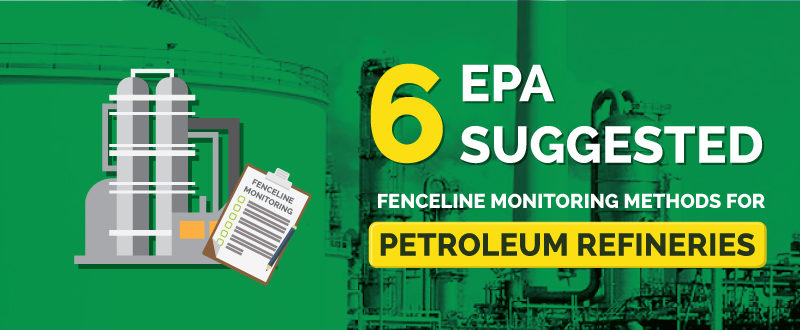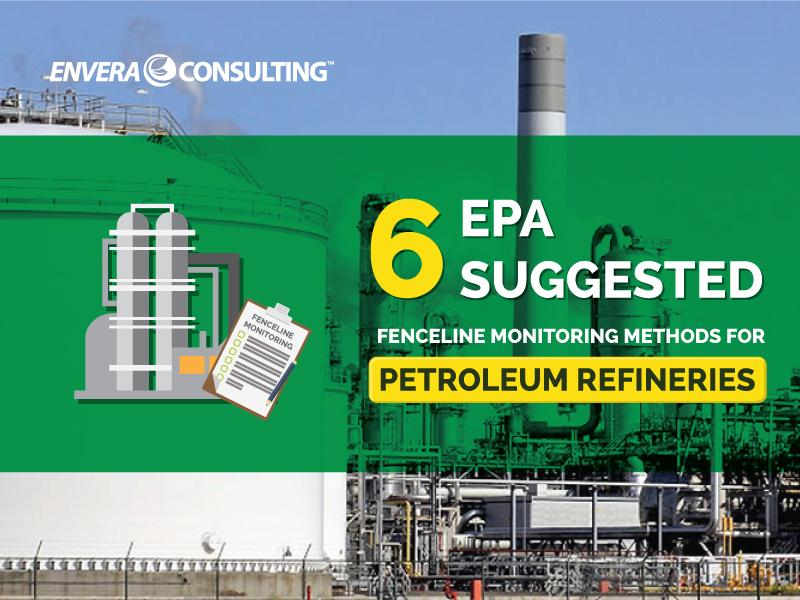

Ambient air monitoring at the fenceline of petroleum refineries is a hot topic around the water cooler these days.
Why?
From 1995 to 2002, the Environmental Protection Agency (EPA) established a number of rules for controlling emissions from petroleum refineries (79 FR 26880) in order to “address the risk remaining after application of [these] standards.”
Over the past year, the EPA has been proposing more changes to the rules. One of the numerous rule amendments is that refineries will be required to continually monitor the concentration of pollutants at their facility perimeter, also known as the fenceline.
Why Fenceline Monitoring?
The EPA reasons that fenceline monitoring will “ensure [that] proposed standards are being met and that neighboring communities are not being exposed to unintended emissions.”
Since fenceline monitoring is a relatively new approach to controlling emissions from a refinery, the EPA has proposed monitoring requirements for only benzene, which is found at most refineries.
(You can see another presentation on ambient monitoring for regulatory compliance here, and you can view the active fenceline monitoring programs already in place at two refineries in Northern California here).
Under the proposed rule change, refineries will be required to set up fenceline monitors around their facilities and semiannually submit the data collected by these monitors to the EPA. In addition to collecting data, refineries will need to make corrective actions if the benzene levels exceed a rolling annual average of 9 μg/m3 (micrograms per cubic meter).
As part of the proposed rule, the EPA suggests six fenceline monitoring methods that refineries can use to comply with the proposed regulations. The following is a summary of each method, including the associated advantages, disadvantages, and operational costs.
1. Passive Diffusive Tube Monitoring Network
The underlying concept behind diffusive tube monitoring is the adsorption of the target pollutant onto a tube monitor, which has a special cap to allow air to enter at a fixed rate. If a target pollutant is present in the air, it will stick to the adsorbent inside the tube. Following the exposure, these tubes can be removed from the field and analyzed in a lab, provided that the tubes were properly exposed to the ambient air (which takes about two weeks).
Pros: Within the proposed rule, the EPA has confirmed through various studies the long-term effectiveness of passive diffusive tube monitoring, specifically for benzene. When the outcomes are combined with low setup and maintenance costs, passive diffusive monitoring is a top choice for meeting fenceline monitoring requirements.
Cons: The disadvantages of this method include data with low time resolution and possible contamination of samples during transits to the lab.
Costs: The EPA estimates that large refineries, which are assumed to have 24 sampling locations, will spend up to $100,000 on equipment and installation. The agency also estimates that the approximate annual operational and maintenance costs for a 24-unit system to be $40,000 a year.
2. Active Monitoring Station Networks
Active monitoring stations are similar to passive diffusive tubes in that the same principal method of detection is used: materials get drawn into the sampler. One of the main differences is that active monitoring uses pumps to draw in ambient air.
Pros: The use of a pump allows for quicker data collection and, thus, greater time resolution. An active sampling system can be attached to the monitoring stations, which can further increase the rate of sample analysis.
Cons: Although this method is well-established and has been used in a variety of settings, the high cost is a major drawback.
Cost: The EPA estimates installation and equipment costs and maintenance costs to be two and ten times that of passive diffusive tube monitoring, respectively. Part of the reason for this significant difference is the need for highly trained personnel to operate and maintain the monitoring equipment.
3. Ultraviolet Differential Optical Absorption Spectroscopy (UV-DOAS)
UV-DOAS is categorized as “open-path” technology, meaning it uses a continuous beam of light to detect pollutants across an open path. In this case, UV light is emitted from a source that points towards a detector.
Pros: Benefits of this method include fewer monitoring stations when compared to the adsorption method, since the distance between the source and the detector can be more than 500 meters. Real-time data with a low detection threshold is attainable with this method.
Cons: On the downside, this method is prone to interference from visible emissions like dust and smoke.
Costs: The costs of this method are higher than both adsorption methods because the technology is more advanced. The EPA estimates $500,000 for a complete fenceline monitoring set-up, which includes four beam-detector systems and four equipment shelters. The agency also estimates that maintaining these systems at two fenceline locations will cost nearly $1,000,000 annually.
4. Open-Path Fourier Transform Infrared Spectroscopy (OP-FTIR)
OP-FTIR is similar to UV-DOAS, but instead of UV light, an OP-FTIR uses infrared light that has spectral interferences with carbon monoxide (CO), carbon dioxide (CO2), and water vapor, which makes organic vapors harder to detect.
Pros: According to a paper published by the EPA, “OP-FTIR is the most powerful and flexible technology for use in long-term monitoring programs at E&P sites as it can monitor almost all compounds of interest simultaneously.”
Cons: A significant disadvantage of the OP-FTIR method is that benzene has a high detection threshold, which means FTIR is less sensitive to benzene as compared to other materials. All else being equal to UV-DOAS, the EPA does not recommend FTIR for the purposes of benzene fenceline mentoring.
Cost: $150,000-$200,000 (according to a 2014 report on the AQMD website).
5. Differential Absorption Lidar Monitoring (DIAL)
DIAL monitoring is slightly different than the two open-path systems of OP-FTIR and UV-DOAS. In DIAL monitoring, two wavelengths of light — one strongly absorbed by the target pollutant, one weakly absorbed by the same pollutant — are emitted in pulses across a path. Light from these beams becomes backscattered as the beams encounter particles and aerosols. A detector adjacent to the light source picks up the backscattered light and measures the difference between the signal strength of the two pulsed beams. The timing of the received light allows for the distance between the plume of pollution and the DIAL apparatus to be calculated.
Pros: Typically, DIAL monitoring is used for specific short-term studies and has been used to measure emissions from a refinery and other petrochemical sources.
Cons: Coupled with its limited availability in the U.S. and its need for highly trained personnel, the EPA does not recommend the use of DIAL monitoring as a long-term fenceline monitoring solution.
6. Solar Occultation Flux (SOF) Monitoring
Solar occultation flux monitoring is another open-path technology that uses the sun as the light source and either a UV or FTIR detector. A van equipped with either detector is driven around the perimeter of the facility to record emissions data.
Pros: This method provides excellent spatial resolution compared to the other open-path methods and is less costly than a DIAL system, though high costs are still an issue because this method requires a full-time staff to operate the vehicle.
Cons: More importantly, this method is dependent on the presence of the sun. Consequently, the EPA does not advise the use of solar occultation flux monitoring.
Costs: Unknown, but there are some examples in a 2014 paper from the AQMD.
Feasibility of the Six Monitoring Methods
The EPA suggests the use of passive diffusive tube monitoring as the primary monitoring option, followed by active sampling, UV-DOAS, and FTIR, respectively.
Passive monitoring’s low costs and ease of setup and maintenance trump its lack of high-quality data relative to the other methods. DIAL monitoring and solar occultation flux monitoring have critical flaws that remove them from consideration.
Regardless of which method is used, the implementation of fenceline monitoring will require additional effort by refineries because facilities must have the monitoring stations installed around their perimeter.